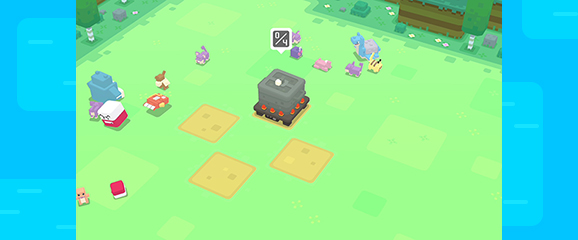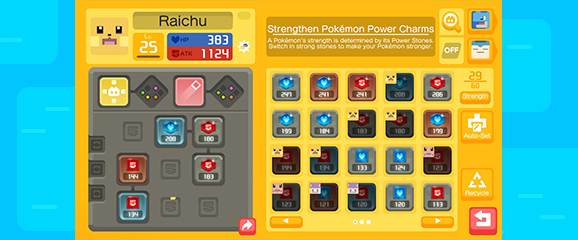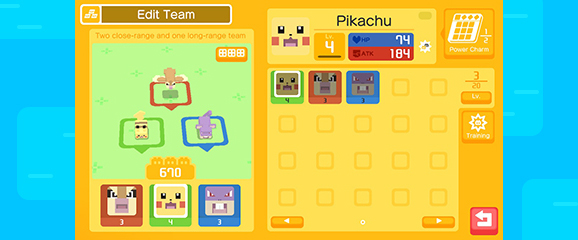
Here’s A Starter Guide For Pokemon Quest Beginners
The Pokemon Company has prepared a starter guide for beginners new to exploration RPG Pokemon Quest, which is now available to download for free on Nintendo Switch.
The starter guide shares a few tips for beginners to get a head start in Pokemon Quest. Read it below.
Your First Choice is a Key to Start
You’ll start out your journey by selecting your first partner Pokémon: Bulbasaur, Charmander, Squirtle, Pikachu, or Eevee. Your choice can have a big impact on your adventures, especially as you take on the initial stages.
Each Pokémon in Pokémon Quest has an Attack stat and a HP stat. Attack indicates how much damage they’ll deal, while HP is a measure of how much damage they can endure. The stats for your potential first partner Pokémon run the gamut—Charmander is strong offensively, Bulbasaur is very defensive, and Eevee provides an equal balance of both. It’s up to you if you’ll pick your favorite or the one that fits your desired strategy.
Unlike some other Pokémon games, your Pokémon’s type won’t cause it to take more or less damage from specific attack types in Pokémon Quest, but you can gain bonus Team Strength by including Pokémon of a specific type on your team. Each first partner Pokémon will make one early area easier, but you may find some types of Pokémon—and the bonus they provide—are less common than others, like Charmander’s Fire type.
Attract New Pokémon with Tasty Cuisine
In Pokémon Quest, instead of throwing Poké Balls, you’ll attract new Pokémon to your team by cooking. You can cook by tapping the pot located at the center of your camp and selecting ingredients. The dish you create will determine which Pokémon you’ll attract and how many stages you’ll need to take on before it’s done cooking. Whenever your pot is empty, be sure to fill it up with ingredients.
Once cooking completes, new Pokémon will enter your base camp. The game will also record the name, description, and ingredients for the recipes you create to make it easier to repeat dishes later. Each recipe can attract lots of different Pokémon, and some are rarer than others.
Most recipes attract Pokémon of a specific color or type, so be thoughtful about the ingredients you select. To start out, try cooking with many ingredients that are the same color. Cooking this way will often create recipes that attract Pokémon that are a similar color to the ingredients.
The texture of the ingredients you include can make a difference, too. For example, if you’re looking to add Pikachu to your team, you should create a dish including both yellow ingredients and soft ingredients. That’s a surefire way to make something favored by Electric-type Pokémon!
Square Your Pokémon’s Power
Your Pokémon will get stronger as they complete stages, allowing them to take on more difficult challenges. Each Pokémon has a level, just like they do in Pokémon games such as Pokémon Ultra Sun and Pokémon Ultra Moon. They’ll gain Exp. (experience points) toward leveling up every time you take on a stage, and each new level increases Attack and HP. In addition, finishing a stage will earn you Power Stones that can further boost your Pokémon’s stats. Your Pokémon will sometimes gain new sockets to equip those stones in by leveling up.
All Pokémon that evolve in Pokémon Quest do so by reaching a certain level. Pokémon that evolve by leveling up in other Pokémon games, such as Squirtle, will evolve at the same level they do in those games. What about Pokémon known to evolve with means other than leveling up, including Pikachu and Eevee? You’ll have to discover for yourself!
Beyond the experience earned by adventuring, Pokémon can also gain Exp. through Level-Up Training. Only one Pokémon will acquire experience each time you train, and to help them power up, you’ll need to say farewell at least one other Pokémon. Training with a Pokémon of the same species will get your Pokémon much more experience than training with Pokémon of a different species.
Empower Your Pokémon with Power Stones
Power Stones will be introduced to you shortly after you start playing. These handy items can be equipped to your Pokémon’s Power Charm to increase their Attack or HP. You’ll usually gain at least one new Power Stone each time you complete a stage.
Most sockets in a Power Charm can equip Power Stones that increase only HP or Attack. Different Pokémon will have different sockets—more defensively oriented Pokémon usually get more sockets that boost HP, while more offensively oriented Pokémon usually have more sockets that increase Attack.
Some rare Power Stones will provide special bonuses in addition to increasing Attack or HP. For instance, an Attack-increasing Power Stone may also give your Pokémon’s attacks increased Critical Hit Rate or Knockback Distance. You’ll normally want to equip Power Stones that maximize your stats, but it could be worth using a Power Stone with a great bonus and a slightly lesser contribution to Attack or HP.
You’ll only be able to keep a limited number of Power Stones in your inventory. You can recycle them to get more ingredients, or you can increase the number of Power Stones you can hold by spending PM Tickets, the in-game currency.
Make Your Moves
Each Pokémon can know only one or two moves at a time. Pokémon of the same species can perform very differently in battle depending on which moves they know. Different attacks can have wildly different ranges and effects, such as attacking the area directly in front of the Pokémon or firing projectiles at far away foes. Since your Pokémon will move on their own, you’ll spend much of your time commanding your Pokémon to use their attacks by tapping the associated icons.
The moves your Pokémon know will impact how well they work together. A close-range Pokémon with a move that knocks foes backwards, like Roar, can be a great choice to protect Pokémon that attack from long range. Just be careful not to use this sort of attack from the wrong side of your enemies, or you might send foes vaulting into your backline instead of away from it!
If you’re not happy with a beloved Pokémon’s moves, you can use Move Training to help it learn a different one. It’ll be up to luck to find out what move the Pokémon will learn, or even if it’ll learn a new one at all. Again, you’ll have to say farewell to another Pokémon to train, and training with a Pokémon of the same species will give your Pokémon a much higher chance of learning a new move.
Moves have their own version of Power Stones called Move Stones, which can be used to change the properties of moves. Bonuses from Move Stone vary, from simpler effects like increasing the range of moves to incredible changes like increasing the number of projectiles a move launches.
Take Three for the Team
You can include three Pokémon in your party at any time. You’ll get three right off the bat—Pidgey, Rattata, and your chosen first partner Pokémon.
You’ll quickly notice Pidgey acts very differently in battle than Rattata does. Pidgey attacks from long range instead of close range, so it’ll try to stay out of the heat of combat and attack from a distance. All Pokémon trend toward either short or long range, and how many of each you include in your party will greatly impact your strategy.
If you’re facing opponents with dangerous close-range attacks, you may want to use Pokémon that keep their distance for safety. Close-range Pokémon tend to excel in situations where you’ll face larger waves of enemies, and they tend to be a little sturdier, too.
Your Pokémon‘s individual Attack and HP stats are added up to determine your Team Strength. Each stage has a different recommended Team Strength, but you may find what you actually need to be higher or lower depending on how well your team fits the challenge. Remember that each stage has a “weakness” that one type of Pokémon can exploit to net you extra Team Strength. Including Pokémon of this type on your team will make it much easier to complete the stage.
Try to build up a large collection of Pokémon so you can adjust your strategy depending on the situation.
Run—Don’t Get Boxed In
You won’t have full control of your Pokémon’s movements in Pokémon Quest. Instead, they’ll venture on toward enemies on their own. Your Pokémon will do their best without you, but they’ll perform better against tougher foes when you help them out. You can encourage them to make a tactical withdrawal by using the scatter button located on the right side of the screen. You can also use this function to help your Pokémon group up when they’ve been separated.
Scattering may seem unnecessary when you first get started, but it’s crucial against more challenging foes. The boss Pokémon that appear at the end of stages become more formidable quickly, and you’ll need to adjust your strategies to defeat them. These Pokémon often telegraph their most powerful attacks by charging up. If you have your Pokémon scatter just before one of these attacks completes, they’ll be able to avoid taking damage entirely.
This tip isn’t just for boss Pokémon. You should also keep an eye out for dangerous attacks from other Pokémon. We’d suggest being particularly careful with Pokémon like Voltorb that are known to Self-Destruct…
Parting Shots
Make sure to log in every day to get some free PM Tickets, and new Pokémon may show up at your camp regularly, too. And don’t forget about completing challenges—they’re a great way to get extra tickets and ingredients! Clearing areas can earn you decorations that will give you special bonuses or more kinds of cooking pots to make better quality dishes.
This guide should help you get started, but some things can be learned only through experience, so get out there and take on Tumblecube Island!







